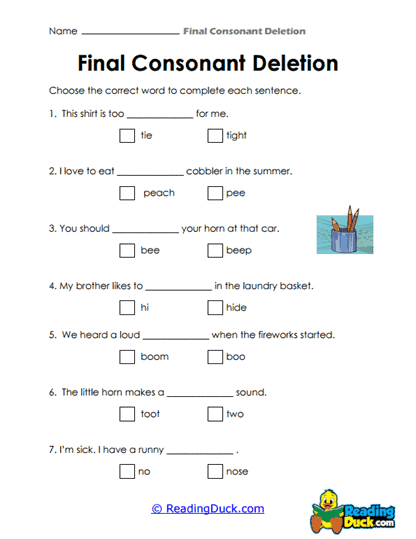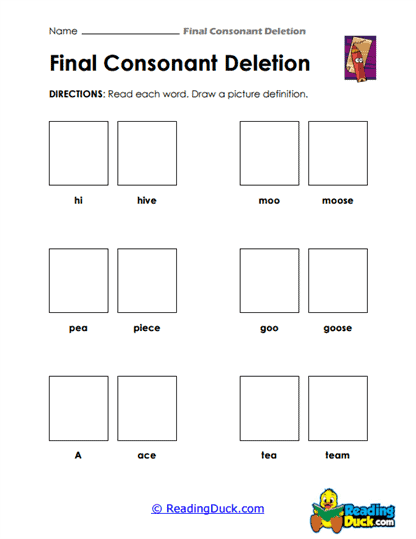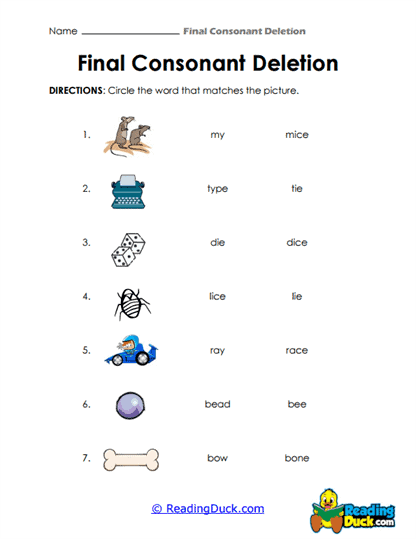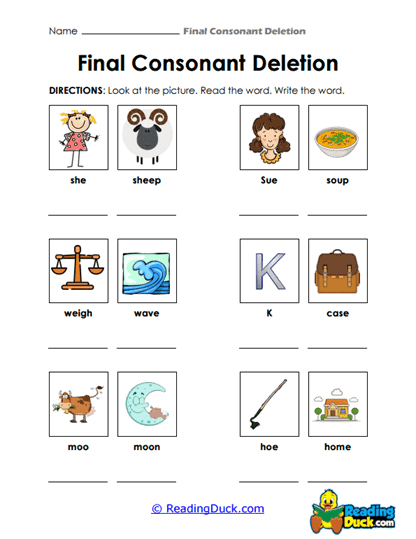Final Consonant Deletion Worksheets
About Our Final Consonant Deletion Worksheets
Final consonant deletion is a common phonological process, particularly among young learners and individuals facing speech and language challenges. It occurs when the final consonant sound in a word is omitted, potentially altering the meaning and clarity of speech. For example, saying "ca" instead of "cat" or "do" instead of "dog" can lead to misunderstandings and hinder communication. Final consonant deletion worksheets are powerful tools that target this specific issue, guiding learners to recognize and correct such omissions in a structured and engaging way. By doing so, these worksheets bridge the gap between spoken and written language, ensuring that learners can effectively convey their ideas while building a strong foundation for literacy.
The primary goal of these worksheets is to cultivate an acute awareness of ending sounds, an essential component of phonemic awareness. Phonemic awareness refers to the ability to hear, identify, and manipulate individual sounds (phonemes) in spoken words. Recognizing the presence and significance of final consonants not only improves pronunciation but also enhances a learner's ability to decode and spell words accurately. For instance, understanding that the "t" sound in "cat" differentiates it from "cab" empowers students to grasp the nuances of language, which in turn improves their reading comprehension and written expression. These worksheets provide a variety of exercises, such as matching, fill-in-the-blank, and sound identification activities, to ensure learners engage with final consonant sounds in diverse and meaningful contexts.
By helping students recognize and correct omissions, these worksheets foster phonemic awareness, improve pronunciation, and enhance spelling accuracy. They also build students' confidence and equip them with the skills necessary for effective communication and academic success. Through structured and engaging practice, learners not only overcome speech challenges but also discover the joy and power of language.
These types of worksheets are instrumental in fostering confidence among students who may struggle with articulation or literacy skills. Language difficulties can often lead to frustration and a reluctance to participate in classroom discussions or social interactions. By offering targeted practice, these worksheets create a safe space for learners to experiment with sounds, make mistakes, and ultimately improve without fear of judgment. As students become more adept at identifying and using final consonants, they gain a sense of accomplishment that motivates them to tackle more advanced linguistic challenges. This boost in confidence extends beyond language skills, encouraging a growth mindset that benefits all areas of learning.
Proficiency in recognizing final consonants directly impacts a student's ability to write correctly, a skill crucial for academic and professional communication. For instance, learning to distinguish between "bag" and "bat" on a worksheet translates into real-world applications, such as writing essays, completing assignments, or even filling out forms. By addressing final consonant deletion early on, educators can lay a solid groundwork for students' overall literacy development, setting them up for success in school and beyond.
What is Final Consonant Deletion?
Final consonant deletion is a linguistic phenomenon typically observed in early childhood as part of natural language development. It occurs when a speaker omits the final consonant in a word, altering its pronunciation. For example, the word "dog" might be articulated as "do," or "hat" may be simplified to "ha." This phonological process is especially prevalent among young children who are just beginning to acquire the complex motor and cognitive skills needed for articulate speech. At this stage, their developing minds often simplify word structures as they navigate the intricate rules of language.
While final consonant deletion is a normal part of early language learning, its persistence beyond a certain developmental stage can have significant implications for communication. Final consonants carry vital linguistic weight; they frequently convey grammatical information, such as tense (e.g., "talked" vs. "talk"), and clarify meaning by differentiating words that would otherwise sound similar (e.g., "cat" vs. "cap"). Without these sounds, speech can become ambiguous, leading to misunderstandings or requiring additional context for clarity. For example, saying "I fed the ca" instead of "I fed the cat" forces the listener to infer meaning, potentially hindering efficient communication.
Implications for Literacy and Learning
The impact of final consonant deletion extends beyond verbal communication, influencing critical literacy skills such as reading and spelling. Consonants, particularly those at the end of words, play a crucial role in phonemic awareness-a foundational component of decoding and encoding words. If a child consistently omits final consonants in speech, they may struggle to recognize or reproduce these sounds in written form, creating barriers to literacy development. This can lead to challenges in academic performance, as reading and writing skills are integral to nearly every area of learning.
Intervening when final consonant deletion persists is essential to ensure children can communicate effectively and achieve academic success. Speech therapy is a valuable resource, providing targeted exercises to strengthen a child's ability to produce final consonants and increase their phonological awareness. Parents and educators can also play a role by modeling clear articulation and engaging children in interactive activities that emphasize these sounds, such as rhyming games or word segmentation exercises. By addressing final consonant deletion early and strategically, we can support children in mastering this critical aspect of language, empowering them to communicate and learn with confidence.
Types of Exercises
Our worksheets were designed to address this challenge employ a variety of exercises, each contributing uniquely to the development of auditory discrimination, phoneme awareness, and spelling accuracy. By engaging students in structured activities, these worksheets provide a scaffolded approach to mastering final consonant sounds. Let's explore the types of exercises typically included in these worksheets and their broader implications for language learning.
Listening exercises form the cornerstone of final consonant deletion intervention, training students to distinguish between words with and without final consonants. For example, when a teacher says "ba" and "bat," students learn to detect the subtle auditory difference between the two. This activity not only sharpens auditory discrimination skills but also heightens the student's ability to focus on sound details that are often overlooked. Such exercises play a crucial role in fostering phonemic awareness, which is foundational for reading and spelling proficiency. By improving their auditory sensitivity, students begin to recognize patterns in language, enabling them to generalize this skill across new words and contexts.
Matching games, which pair images with correctly spelled words, make learning tangible and engaging. By associating a picture of a dog with the word "dog" rather than "do," students bridge the gap between language and meaning. This visual and interactive approach caters to diverse learning styles, particularly benefiting students who thrive in kinesthetic or visual learning environments. Moreover, these activities encourage independent problem-solving, as students must use their knowledge of sounds and word structures to make the correct match. The gamified nature of this exercise also reduces the pressure often associated with learning, creating a positive and enjoyable educational experience.
Reading and rewriting exercises, where students correct sentences missing final consonants (e.g., "The ca is black" to "The cat is black"), challenge them to apply their knowledge in meaningful contexts. This type of activity not only reinforces spelling and grammar rules but also improves reading comprehension by requiring students to interpret and reconstruct sentences. Coupled with phoneme practice, where students isolate and articulate final consonant sounds (e.g., emphasizing the /t/ in "hat"), these exercises develop confidence in both oral and written communication. Through repetition and practice, students internalize the rules of language, enabling them to express themselves clearly and effectively.
By incorporating diverse activities like listening tasks, word completions, matching games, and phoneme practice, these worksheets offer a holistic approach to learning. They not only address specific phonological issues but also lay a strong foundation for broader literacy skills, ensuring students are equipped to succeed in both academic and everyday communication.









